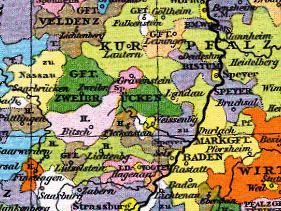Government Principality Founded 1381 | Preceded by Succeeded by Capital Saarbrücken | |
 | ||
Historical eras Middle Ages, Early modern period | ||
The County of Saarbrücken was an Imperial State in the Upper Lorraine region, with its capital at Saarbrücken. From 1381 it belonged to the Walram branch of the Rhenish House of Nassau.
Contents
County of Saarbrücken
Around the year 1080 King Henry IV of Germany vested one Count Siegbert in the Saargau with the Carolingian Kaiserpfalz at Wadgassen on the Saar River and further possessions held by the Bishops of Metz in the Bliesgau as well as in the adjacent Alsace and Palatinate regions as a fiefdom.
In the course of the fierce Investiture Controversy, the rise of the comital dynasty continued with the appointment of Siegbert's son Adalbert as Archbishop of Mainz in 1111, and in 1118 his elder brother Frederick was first mentioned with the title of a "Count of Saarbrücken". However, Frederick's son Simon I had to face the slighting of his Saarbrücken residence by the forces of Emperor Frederick Barbarossa in 1168. Upon his death about 1183, the county was divided into two parts, when the Palatinate territories were separated to form the basis of the County of Zweibrücken. The Alsatian possessions had been lost already around 1120.
When the comital House of Leiningen became extinct in 1212, the Counts of Saarbrücken by jure uxoris inherited their Palatinate possessions around Altleiningen Castle, where they established the younger line of the Counts of Leiningen as a cadet branch. Simon III of Saarbrücken, count from 1207, was a loyal supporter of the Imperial House of Hohenstaufen and of Philip of Swabia. He later joined the Fifth Crusade and, as he had no male heirs, reached the acknowledgement of the inheritance by his daughter Laurette. His younger daughter Mathilda, who succeeded her sister in 1272, managed to secure her right of succession by marrying Count Simon of Commercy who from 1271 called himself Count of Saarbrücken-Commercy.
Saarbrücken received town privileges in 1322. Count John I, liensman of the Lorraine dukes, joined the Luxembourg king Henry VII of Germany on his campaign to Italy and fought with Henry's son John of Bohemia on the French side in the Hundred Years' War. His grandson, the last Count John II of Saarbrücken, likewise fought with the French in the 1356 Battle of Poitiers, where he and King John II of France were captured and until the 1360 Treaty of Brétigny imprisoned at Wallingford Castle. Vested with the Lordship of Vaucouleurs as well with the title of a Grand Butler of France, he nevertheless had to pawn large parts of his possessions to Archbishop Baldwin of Trier. With John's death in 1381 the male line ended again. As his daughter Johanna had married Count John I of Nassau-Weilburg in 1353, their son Philipp I inherited the County of Saarbrücken.
County of Nassau-Saarbrücken
Philipp I ruled both Nassau-Saarbrücken and Nassau-Weilburg and in 1393 inherited through his wife Johanna of Hohenlohe the lordships Kirchheimbolanden and Stauf. He also received half of Nassau-Ottweiler in 1393 and other territories later during his reign. After his death in 1429 the territories around Saarbrücken and along the Lahn were kept united until 1442, when they were again divided among his sons into the lines Nassau-Saarbrücken (west of the Rhine) and Nassau-Weilburg (east of the Rhine), the so-called Younger line of Nassau-Weilburg.
In 1507 Count John Ludwig I significantly enlarged his territory by marrying Catharine, the daughter of the last Count of Moers-Saarwerden and in 1527 inherited the County of Sarrewerden including the lordship of Lahr. Though after his death in 1544 the county was split into three parts, the three lines (Ottweiler, Saarbrücken proper and Kirchheim) were all extinct in 1574 and all of the Nassau-Saarbrücken was united with Nassau-Weilburg until the year 1629. This new division however was not executed until the Thirty Years' War was over and in 1651 three counties were established: Nassau-Idstein, Nassau-Weilburg and Nassau-Saarbrücken.
Only eight years later, Nassau-Saarbrücken was again divided into:
By 1728 Nassau-Saarbrücken was united with Nassau-Usingen which had inherited Nassau-Ottweiler and Nassau-Idstein. In 1735 Nassau-Usingen was divided again into Nassau-Usingen and Nassau-Saarbrücken. In 1797 Nassau-Usingen finally inherited Nassau-Saarbrücken, it was (re-)unified with Nassau-Weilburg and raised to the Duchy of Nassau in 1806. The first Duke of Nassau was Frederick August of Nassau-Usingen who died in 1816. Wilhelm, Prince of Nassau-Weilburg inherits the Duchy of Nassau. But, territories of Nassau Saarbrücken was occupied by France in 1793 and was annexed as Sarre department in 1797. Finally County of Nassau-Saarbrücken was part of Prussia in 1814.
The coat of arms combined the lion of the counts of the Saargau with the crosses of the house of Commercy, and was used when the coat of arms of Saarland was created.
Possessions in 1797
Rulers
House of Leiningen
House of Broyes-Commercy
House of Nassau
